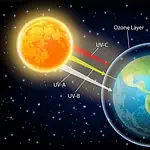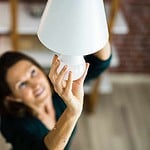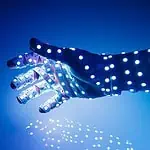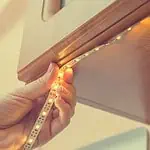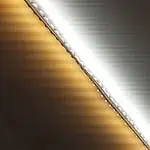There are several misconceptions that LEDs don’t emit UV rays. Several studies and research have verified the presence of UV rays and optical radiation from LEDs. The amount of UV rays emitting from an LED bulb is significantly less, almost negligible. Furthermore, radiation from LEDs is usually harmless, but seeing an LED bulb for too long can be harmful. There is a phosphor inside LED lights, which is responsible for producing white light. While white light is created, a tiny amount of UV is also produced.
Now that we’ve understood that LEDs generate negligible UV radiation, the next question arises whether that UV radiation from LEDs is harmful. In this article, you’ll learn in detail about Ultraviolet Rays, radiation, and different types of lights that generate UV rays.
UV Rays Briefed
UV rays are those rays coming from the sun that are invisible but contribute to their energy. UVA and UVB are the two types of UV rays that make up the ultraviolet radiation that reaches the earth’s surface. Sun lamps and tanning beds are additional sources of ultraviolet radiation. It may result in skin cancer, melanoma, premature aging, and other skin problems. Additionally, the immune system and eyes may be affected as a result. Skin care professionals advise using sunscreens that shield the skin from UV radiation. When used to treat specific skin disorders like psoriasis, vitiligo, and cutaneous T-cell lymphoma, ultraviolet radiation from unique lamps or a laser is also employed in the healthcare sector.
For more information, you can read What Is The Difference Between UVA, UVB, And UVC?
Radiation Briefed
Radiation is energy that originates from a source, traverses space, and has the potential to pierce a variety of materials. Non-ionizing radiation includes microwaves, radio waves, and light.
Energy can be emitted as particles or waves through this process called radiation. Generally, it can appear as light, heat, or sound. However, most people typically use this term to refer to radiation from electromagnetic waves, including radio waves, visible light spectrums, gamma waves, and more.
Although the human eye cannot see ultraviolet (UV) radiation, it can cause some materials to fluoresce—that is, to generate electromagnetic radiation with lower energy, like visible light—when it hits them. Atomic excitation in a gaseous discharge tube produces discrete ultraviolet radiation and continuous ultraviolet radiation from high-temperature surfaces like the sun. Most UV rays from sunlight are absorbed by oxygen in the atmosphere, creating the lower stratospheric ozone layer. Nearly 99 percent of the ultraviolet energy that reaches the earth’s surface is UVA radiation.
Do LEDs Emit UV Rays?
Like all other electronic items, LED bulbs emit EMF (Electromagnetic field) radiation less frequently than other gadgets. One advantage of LEDs is their energy efficiency, which means they use less electricity than what is typically pulsed through the wires to operate. Unwanted electricity is returned through the cables, and as a result, dirty electricity is created, resulting in the emission of Extra Low Frequency (ELF) radiation. This tells how much electricity “travels” via power lines, where just 50/60 Hertz AC electricity ought to. “Dirty electricity” refers to any other amount of power, not in this frequency.
It is observed that UV radiation causes sunburn and, in more extreme cases, can result in vision problems, skin cancer, immune system deterioration, and other diseases. Fortunately, UV emissions from most artificial light sources are insufficient to justify any significant alarm. The UV that CFL bulbs emit is being investigated in addition to their mercury content. Even though CFLs don’t emit a lot of UV, some people who are particularly sensitive to UV might be negatively impacted by it. Color deterioration in UV emission is another issue.
Due to UV emissions, CFL and HID bulbs have been known to harm curtains, carpets, painted surfaces, and more. This has served as an additional incentive for places like museums to upgrade to LED lighting. Given the low UV intensity of LED, it is understandable why LED tanning lights are not readily available in the United States. Making them effective, long-lasting, and affordable is the problem, not so much that it cannot be done.
Do LEDs Emit Radiation?
Yes, they produce a lot of radiation from visible light sources that appear white to our eyes.
Since it does not fall into the X-ray or gamma regions of the electromagnetic spectrum, it is not ionizing and hence not hazardous until it reaches a concentration that can operate as a laser and set objects on fire. As implied by its name, ionizing radiation produces ions. This harms your body because it frequently triggers unintended chemical reactions inside the nucleus of your cells. However, it is safe since LED lighting does not fall under this wavelength.
UV Radiation and Halogen
A halogen lamp operates at extremely high temperatures and emits significant UV radiation. Halogen bulbs require unique filters and casings because of this. Consider switching to LED lamps and fixtures if you are concerned about UV radiation exposure while using fluorescent lamps and fixtures. Modern LED bulbs do not emit UV radiation.
Types Of Lights Emitting UV Rays
- Incandescent Lighting
The most popular light bulbs in homes, incandescent bulbs, emit a small amount of UV light. These bulbs emit UV light, but it is so minute that it cannot possibly have any discernible impact on human health. Incandescent lights don’t burn skin and also don’t promote vitamin D absorption in people or animals. These lights exclusively release UVA rays.
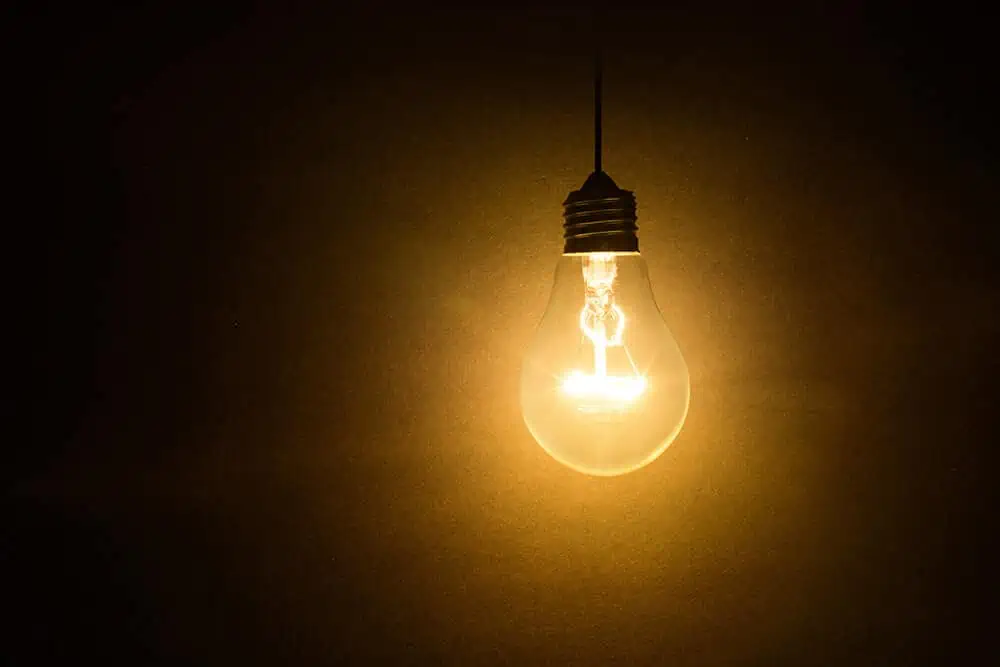
- Fluorescent Lighting
The two types of fluorescent bulbs most frequently used in residential and commercial buildings are compact fluorescent bulbs and fluorescent tube lighting. Both light sources produce more UV light than conventional incandescent bulbs. Although the UVA radiation released by these bulbs is too weak to cause an immediate effect like sunburn or eye pain, some experts have shown concern about the long-term effects these lights have on human health.
- UVB Lighting
Sunlight’s UVB rays assist in the absorption of vitamin D by living things and may also help to fight against diseases like seasonal affective disorders. But excessive UVB sunlight can potentially harm your skin. UVB bulbs, often referred to as retile basking lights, are typically found at pet stores and release significantly more UV rays than fluorescent or incandescent light bulbs. Similar to how they are used in pet stores, these bulbs are most frequently used as an additional lighting source for reptiles and amphibians in the house. These animals require UVB rays to digest calcium.
- Tanning Lights
Long, tubular fluorescent lamps that emit UVA and UVB rays are typically used in tanning beds. These lights may promote vitamin D production and seasonal affective disorder but can also damage the skin and cause cancer.
- The Sun’s Light
The best-known and most potent source of UVA and UVB light is sunlight. This light is passed through the earth’s ozone layer and is far less powerful than the light it was at the origin. Although sunlight is essential for human life and health, excessive exposure has been linked to many health issues, including skin cancer and genetic abnormalities. The amount of UV light hitting the earth and the species that live on it has increased in recent years due to holes in the ozone layer.
Advantages of LED Lighting
LED lighting offers much to industrial and commercial companies looking to cut expenses and energy usage. Here are a few benefits of LED lighting:
- A prolonged Lifespan
The lifespan of an LED light is far longer than that of a regular incandescent bulb. The normal lifespan of an incandescent light bulb is 1,000 hours, whereas a standard LED light has a 50,000-hour lifespan. Its lifespan could exceed 100,000 hours, depending on how you manage it. This states that an LED light can last anywhere from six to twelve years before it needs to be changed. In comparison to incandescent light, LEDs seem to last 40 times longer.
- Energy Efficiency
Useful lumens, a standard metric for assessing how energy-efficient a lighting source is, evaluate how much light a device generates for every watt it consumes. Although part of these lumens is really wasted in use, the number of lumens produced can be used to measure the amount of light. Compared to traditional lighting systems, LED lighting generates more useable lumens while generating less waste light. If you replace all of the lights in your office, school, or other establishments with LEDs, your overall energy efficiency may rise by as much as 60% to 70%. The improvement may be as much as 90% in some cases, depending on the type of lighting you replace and the kind of LED lights you utilize.
- Enhances Environmental Performance
Going green is a corporate strategy that matters more and more. Customers demand more environmentally friendly goods, and selecting an eco-friendly light source can assist businesses in utilizing less energy and attracting a socially responsible audience. Additionally, the manufacturing of LED lights has little effect on the environment. Internally, mercury is used to create numerous types of traditional lighting, including fluorescent and mercury vapor lamps. They require special care when they’re approaching the end of their lives.
- Flexibility in Design
Since LEDs are tiny, they can be applied in nearly any situation. Keep in mind that they were intended to be circuit board indicator lights. When you combine them, they look like traditional bulbs. You can connect LEDs in a series to create decorative lights, such as Christmas, rice, etc.
- Operation at Low Voltage
You should be able to illuminate your facility with equipment that uses the least amount of electricity possible if your company is located in an area where floods could occur. LEDs are perfect for this because they require such low voltage to operate. By employing a low-voltage system in locations subject to flooding, you guard against potentially dangerous or fatal shocks for your employees and others.
- Capabilities for dimming
From around 5% to 100% of power, LEDs operate effectively. Some lighting sources, including metal halide, work less effectively when dimmed. You may not be able to cover them at times. For LED lights, the opposite is true. An LED light performs better when its electricity isn’t used at maximum capacity. Other advantages also emerge from this characteristic. It lengthens the bulb’s lifespan and indicates that you are consuming less energy, which lowers your energy expenditures. It’s crucial to remember that conventional dimming equipment cannot be used when employing LEDs. Hardware customized to their technology is required.
- Directionality
Using conventional lighting methods, light is emitted from the light source in all directions. As a result, if you want the light to focus on a specific region, you will need to buy accessories that will channel or deflect the light in that direction. You will waste energy illuminating places that don’t need illumination if you don’t use something to reflect or deflect the morning, increasing your electricity bills. LED lighting is ideal for recessed lighting in an industrial kitchen, hallway, or bathroom because an LED light can only illuminate a 180° area. Additionally, it is perfect for illuminating artwork because it won’t harm the piece and because no illumination power is lost to the light source’s back.
- Ability to Withstand Frequent Switching and Instant Lighting
LED lighting is the ideal choice if you need a light that needs to turn on instantly. LED lights provide instantaneous on/off capabilities. You must be ready for a warm-up period if you use a metal halide lamp. Consider how a fluorescent light often takes two or three seconds to completely illuminate after being turned on. These are a few issues that installing LED lights can get around. Traditional lighting sources also have a shorter lifespan if you frequently turn them on and off. LED lights are not affected by frequent switching. As a result, they are more efficient and live longer.
Make sure there are no risks associated with the use, cost-savings, ecological benefit, efficiency, and attractiveness of LED technology. This technology may enhance the mood and appearance of your home, contribute to environmental protection, and help you save a lot of money when used in conjunction with modern and appropriate design.
FAQs
Brilliant blues release a tiny amount of UV light, even though most LED lighting does not. The amount released is inconsequential because the phosphor reduces this to a small percentage of the already negligible amount. Since they don’t require a filter, they are frequently utilized in situations where photosensitivity is an issue. One of the numerous reasons LED lighting outperforms high-intensity discharge bulbs is the absence of UV rays.
Although they emit even less UV, LEDs create a tiny amount of it. This is because the phosphors inside the lamp transform most of the light produced into white light since UV radiation is found in the region of the electromagnetic spectrum that makes us apply sunscreen when the sun is at its strongest. UV radiation in excess can result in skin cancer, cataracts, and sunburns. With most artificial light sources, you won’t likely experience these impacts.
Yes, a lot of LED grow lights do release UV radiation. Both natural sources, such as the sun, and artificial ones, such as tanning booths and various types of lighting, release UV rays. Although excessive UV exposure can lead to cancer, small levels of UV radiation are suitable for people and plants, promoting the generation of vitamin D in people and strong growth in plants.
Since most LED household lights don’t emit UV, numerous LED grow lights have been specifically designed to do so. UV light is also emitted by other types of grow lights, such as HID (high-intensity discharge) bulbs.
The answer is that prolonged close-up exposure to LEDs can cause skin damage. LED lights are safer for daily use because they don’t release UV rays like incandescent and fluorescent light bulbs do. At any age, hyperpigmentation can affect millions of people with various skin tones from around the globe. You might or might not be aware that broad-spectrum sunscreens can be used to cure and prevent black spots on the skin.
However, the blue light your phone and computer emit can worsen melasma, dark patches, and hyperpigmentation on your skin. In particular, those with darker complexion tones might relate to this.
If a grow light is utilized incorrectly, it can hurt your plants. As a grower, you’ve probably carefully considered factors like hanging distance, additional cooling, and hydration to ensure your lights promote the health and growth of your plants rather than harming or depleting them. In the case of humans, whether you operate a tiny home grow or a sizable business, it’s critical to comprehend how your lights may put you or your staff at risk.
The intense concentration of LED lights may harm your eyes. LED grow lights are relatively safe from other grow lights. The Federation of National Manufacturers Association for Luminaires and Electrotechnical Components for Luminaires in the European Union, CELMA, has investigated and demonstrated this. However, like with any grow light, it’s crucial to be aware of any potential health hazards associated with utilizing LED grow lights so you can take the appropriate precautions.
Any light can damage our eyesight if it is strong enough. Nevertheless, some types of light are far more damaging than others, and even minute levels of particular lights can hurt your eyes. Simply put, the shorter the wavelength, the more significant harm it does to your eyes.
Blue light and UV light are the wavelengths of light you should be most concerned about, with UV light being more hazardous than blue light. All artificial grow lights have different levels of blue and UV light. Similar to HPS, reddish grow lights only have significant levels. Much more is present in bluer lights, such as Metal Halide or fluorescent. The installation of LED grow lights are more complicated.
In industrial applications and other contexts, most LED light bulbs don’t emit UV radiation. Because they couldn’t create white light in their early versions, LED lighting did not release UV rays. However, this has altered with the introduction of white light LEDs. Brilliant blue LEDs are covered in the phosphor to produce white LED lamps.
This enables the white to shine while absorbing the blue. Brilliant blues release a tiny amount of UV light, although most LED lighting does not. The amount released is minimal because the phosphor reduces this to a small percentage of the already negligible amount.
Since they don’t require a filter, they are frequently utilized in situations where photosensitivity is an issue. One of the multiple reasons LED lighting outperforms high-intensity discharge bulbs is the absence of UV rays.
Recent research has indicated that some blue light wavelengths can also be hazardous to the eyes and cause vision loss, in addition to the potential harm that UV radiation can do to the skin.
Even while the light is a need for living, it’s crucial to understand that exposure to hazardous light can have a detrimental effect on your eyes over the long run and become harmful to your skin. The damaging effects of visible and non-visible light spectrums, incredible UV light, and other high-energy blue light wavelengths require daily protection.
Everyone should protect their eyes from UV rays, regardless of their age. Wearing lenses with complete UV protection on both the front and back surfaces is a simple approach to shielding your eyes.
Related Articles
Halogen vs. LED Bulbs: How To Choose?
Advantages and Disadvantages of LED Lighting
Conclusion
Since some people think that LED lights emit harmful UV rays that might impact their health, they are hesitant to choose them above any other type of illumination. The amount of UV produced by LEDs is negligible compared to that produced by incandescent bulbs, and it is significantly less than other types of lights available in the market.
If LEDs are made to emit radiation, they will do so. This means that LEDs will be specially created to emit the necessary amount of UV radiation when UV rays are needed, such as in medical treatment devices, nail dryers, modular lighting, etc.
LEDYi manufactures high-quality LED strips and LED neon flex. All of our products go through high-tech laboratories to ensure the utmost quality. Besides, we offer customizable options on our LED strips and neon flex. So, for premium LED strip and LED neon flex, contact LEDYi ASAP!
